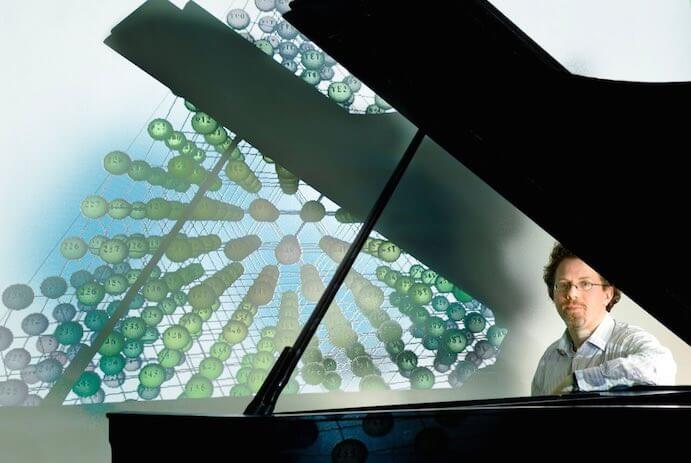In 2015, surreal images produced by AIs as they learned to parse objects launched an internet frenzy. These fever-dreams of thinking machines have entertained and disquieted ever since. Composer Dmitri Tymoczko could hardly have seen this coming when he wrote the pieces on his new album Fools and Angels. Flawlessly recorded by Andrés Villalta and Christopher Ericson for New Focus Recordings’ Panoramic label, these compositions preceded DeepDream. The record nonetheless finds Collide Trio, Newspeak, the Illinois Modern Ensemble, and others conjuring robot subjectivities and psychedelic soundscapes–right on trend. Marc Wolf’s jacket art skews reality starting with the cover, a Renaissance illustration of a jester with a world map in place of a face. The picture gels with the algorithmic bizarreness of our own era, inviting hilarity, confusion, and dim horror all at once. So does Tymoczko’s music.
“Fie my Fum,” the first movement of the title piece, opens with the noodling of a fantasy stadium-pop band, drums crashing and synths agleam. Later, sopranos Anne Hege and Mellissa Hughes wind willowy vocal lines around vague sets of instructions. In “Strawberries and Cream,” a recorded voice delivers Jeff Dolven’s text over the musical equivalent of a desolate Salvador Dalí landscape. Humming from tenor Neil Farrell and baritone Gabriel Crouch adds eeriness, and New Focus label head Daniel Lippel completes the picture with quiet strums on guitar. Saxophonist Geoff Vidal, pianist Pascal Le Boeuf, and drummer Jason Treutling seize chances to groove in “Bop Lyrics,” another Ginsberg setting, and “The Dressing Room,” another from Dolven. “Who” yields tight performances from all, integrating electronic squeals, birdsong, and beeping with live sound.

Sheila63 stands at the heart of the album in both running time and aesthetic. The Illinois Modern Ensemble, a group from the University of Illinois at Urbana-Champaign, here excels under Stephen Andrew Taylor’s direction. Martha Cluver and Caroline Shaw of Roomful of Teeth join Hughes, voicing sentient robot Sheila63 plus various humans. An update of 2001’s HAL for the online retail age, the power-tripping AI delivers fantastic and horrifying items to unsuspecting customers. The soprano trio gives her soul, singing with both coolness and vibrancy as Dexter Palmer’s tale unfolds. The Ensemble delivers on both cinematic sweep and subtler, stranger textures.
Four Dreams features Tymoczko as narrator of his own visions, with music courtesy of Collide Trio. After a dramatic opening, the first dream condenses into a cloud of quasi-jazz, lit from within by Jonathan Sanford’s saxophone. David Skidmore’s vibraphone figures establish a mood of unreality in the second dream, and poet Christian Bök supplies both text and unhinged declamation for the third. In the finale, Jade Simmons plays swelling, sentimental piano in deadpan while a ridiculous marriage scene plays out. In places, Tymoczko’s 2004 scenarios (“is this a gay dream?”) show their age. However, the piece epitomizes his approach to narrative.

After all this absurdist doodling in reality’s margins comes a sobering closer. Let the Bodies Hit the Floor samples a harrowing 2005 interview from This American Life, in which a matter-of-fact Marine describes the violence of the second battle of Fallujah. Backed by funk grooves from massive speakers as he crossed the breach, the soldier felt uninspired; he would have preferred the nü-metal hit “Bodies.” Tymoczko lets the man’s speech hover out of sync for most of the piece. However, he aligns the sentence “uh – ‘Let the Bodies Hit the Floor?’” with crashing sonorities for guitarist Taylor Levine and percussionist Yuri Yamashita. The other members of Newspeak, Hughes included, help make a whole out of this devastating collage.
One promotional blurb for Fools and Angels compares it to 1970s progressive rock. The (platform) shoe fits, but this hardly gives Tymoczko and collaborators due credit. Fools and Angels gathers lovingly engineered syntheses of the art forms that inspired each piece. Tymoczko draws from forms such as spoken-word poetry, free improvisation, and notated ensemble music, and shuffles the deck. Many of the musicians whose work appears in Panoramic’s small but growing catalogue have won acclaim by following comparable paths. Neural nets can mince reality and put it back together the wrong way, amusing and terrifying their putative masters. Yet from map-faced jesters to acid poetry, Fools and Angels reminds us how far good old human imagination can take us.
























